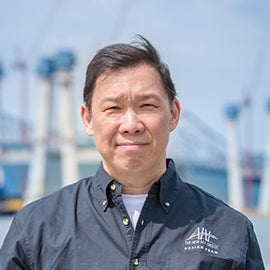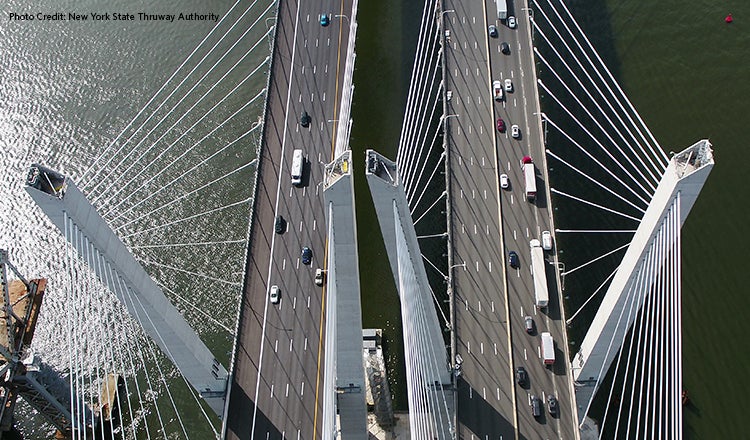
Experts Talk: Mega Project Management for Signature Bridge Delivery with Jeff Han
Experts Talk is an interview series with technical leaders from across our transportation program.
Signature Bridges: Using Highly Technical Teams to Manage Quality and Risk

Designers of important, signature bridges also must be able to develop innovative solutions, coordinate multi-national design teams and execute comprehensive quality plans throughout the entire delivery process. Jeff Han, P.E., serves as a principal project manager for HDR in our Manhattan, New York, office. He is a registered professional engineer in six states with a Bachelor's of Science in civil engineering from the University of Maryland. Jeff brings more than 34 years of progressive experience in structural and civil engineering serving as a project director and project manager on various bridge rehabilitation and replacement projects, such as the New New York Bridge / Governor Mario M. Cuomo Bridge (replacing the Tappan Zee Bridge) and the Bayonne Bridge Navigational Clearance project as well as highway and transit design.
Mega Project Management for Signature Bridge Delivery
Q. What are the top three characteristics that define a signature bridge?
A. First — complexity of structure. The bridge must possess iconic elements that will pass the test of time. Second — importance to the community and traveling public. Signature structures may be viewed as engineering achievements. However, they must serve the community’s needs in order to be truly successful. Third — project scale. The size of these projects separates them from traditional assignments and requires design teams with unique skillsets, and vast technical and operational expertise.
Q. You’re in a meeting with recently graduated bridge engineers who will be on your project team. How would you describe for them the complexity involved in managing a large-scale signature bridge project versus, for example, a typical five-span box girder?
A. To begin, I’d describe what I think are the key attributes of a large-scale project:
- Displays an iconic element such as a cable-stayed bridge
- Demonstrates specialty experience as well as numerous technical disciplines
- Contains numerous components or is geographically extensive
- Requires an unusually large percentage of an owner’s resources (i.e., in some of the larger markets, this would mean projects in excess of $1 billion).
Projects of this scale differ from our more traditional work. These large-scale projects engender added scrutiny. Due to the amount of funding required, these projects are typically highly politicised. This puts pressure on all involved including the owner, contractor and designer. These mega projects also bring additional risk to the designer. More often, these projects are following alternative delivery methods, including public-private partnerships and design-build. Such procurement methods require the designer to work for the owner through for the contractor rather than directly for the owner.
Then one must account for the speed at which these huge projects must be delivered. In order to meet both political and commercial goals, these projects are often fast-tracked and force the designer to be prepared to harness a quantity of resources not required on our traditional projects. Also, one must consider the level of coordination that these projects require. Many times, these projects require international expertise to be brought to bear. This adds complications ranging from language and culture to collaboration across different time zones.
Q. What should project owners look for in a project team if they want to deliver a signature bridge with the greatest value?
A. As I related above, the unique requirements of these projects demand a design team that can mobilize a diverse and extensive array of technical and operational staff in a very short period of time. This allows teams to drive schedules and meet project goals, but requires a designer who can develop innovative solutions, coordinate diverse design teams and execute comprehensive quality plans.
Q. What’s a recent example of how you approach project team management for signature bridge delivery?
A. For the Governor Mario M. Cuomo Bridge management team, I sought to combine strong technical experience and organisational capabilities. To properly manage and coordinate a team for these types of projects in the environment described above, you must have a staff that is not only focused on the issues of the day, but can also keep their eyes on the bigger picture. We were very successful in creating this synergy when implementing our production team. Focused on delivery, they were “mini-PMs” who drove the team through technical development, QA/QC, and contractor and owner approvals.

Q. How do modern tools and technologies support collaboration on the scale needed for signature bridge delivery?
A. Due to the size and diversity of large project teams and the required speed of delivery, using web-based programs like ProjectWise and BlueBeam allows coordinated access and real-time review of documents. For example, version control of working files is extremely important on fast-moving projects. ProjectWise provides project teams a tool to organise and access files easily. When dealing with hundreds of deliverables that must be reviewed over the life of a large-scale project — and thousands of associated comments that must be responded to and resolved — BB offers a tool that enables reviewers to see comments as they are made in real-time and eliminates redundant comments.
Inspiration & Advice: Jeff Han
Q. What inspired you to become a bridge engineer?
A. I like the fact that you can see and touch your work, in many cases on a daily basis. Very few professions offer that type of gratification. As a structural engineer, bridge design impacts entire communities.
Q. What advice do you have for bridge designers who are new to the profession?
A. Learn as much about the entire business as possible. Structural engineering has many aspects. However, to be a strong engineer, you must understand the overall goals of the project — what we are designing in terms of traffic, roadway alignment, drainage, etc. A key is to look for different and varied assignments to equip you with a range of tools and skills.
Each Experts Talk interview illuminates a different aspect of transportation infrastructure planning, design and delivery. Check back regularly to gain insights from specialised experts and thought leaders behind our award-winning, full service consulting practice.

